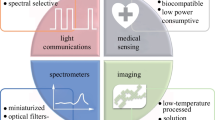Abstract
This work introduces an active feedback structure into the Inverter Cascode Trans-Impedance amplifier design, allowing the enhanced circuit to achieve a reasonable 32 and 84 times improvement in bandwidth and power consumption respectively over the traditional circuit of Inverter Cascode Trans-Impedance amplifier utilizing resistor as feedback mechanism. The gain of the proposed enhancement circuit was determined to be 53.2 dB, with 9.2 GHz bandwidth and 3.2 mW of power consumption, hence the proposed design is appropriate for broad bandwidth applications designed to operate with low supply voltage.





Similar content being viewed by others
References
Aznar F, Gaberl W, Zimmermann H (2011) A 0.18 m CMOS transimpedance amplifier with 26 dB dynamic range at 2.5 Gb/s. Microelectron J 42(10):1136–1142. https://doi.org/10.1016/j.mejo.2011.06.005
Singh V, Kumar N, Kumar M et al (2022) A common-gate cascaded with cascoded self-bias common source approach for 3.1–10.6 GHz UWB low noise amplifier. Int J Inf Technol 14:2389–2398. https://doi.org/10.1007/s41870-022-01001-z
Atef M, Aznar F, Schidl S, Polzer A, Gaberl W (2014) 8 Gbits/s inductorless transimpedance amplifier in 90 nm CMOS technology. Analog Integr Circuits Signal Process 79(1):27–36. https://doi.org/10.1007/s10470-013-0242-4
Park SM, Yoo H (2004) 1.25-Gb/s regulated cascode CMOS transimpedance amplifier for gigabit ethernet applications. IEEE J Solid-State Circuits 39(1):112. https://doi.org/10.1109/JSSC.2003.820884
Choi B, Han J, Yun J, Seo M, Park SM (2008) “Current-mode gigabit optical receivers in submicron CMOS technologies,” ieee asia pacific conference on circuits and systems (APCCAS),Macao, China, pp. 1696–1699, https://doi.org/10.1109/APCCAS.2008.4746365
Atef A, Atef M, Khaled EEM, Abbas M (2020) CMOS Transimpedance amplifiers for biomedical applications: a comparative study. IEEE Circuits Syst Mag.https://doi.org/10.1109/MCAS.2019.2961724
Atef M, Zimmermann “H (2013) Low-power 10 Gb/s inductorless inverter based common-drain active feedback transimpedance amplifier in 40 nm CMOS. Analog Integr Circ Sig Process 76:367–376. https://doi.org/10.1007/s10470-013-0117-8)
Kumar PA, Tamil S, Raj N (2021) Low voltage improved impedance wide bandwidth current mirror. Int J Inf technol 13:2411–2417. https://doi.org/10.1007/s41870-021-00785-w
Monika, Mittal P (2022) A novel modified current comparator based on extremely low voltage high compliance current mirror. Int J Inf Technol 14:323–331. https://doi.org/10.1007/s41870-021-00823-7
Durgam R, Tamil S, Raj N (2022) Low voltage high gain flipped voltage follower based operational transconductance amplifier. Int J Inf Technol 14:1643–1648. https://doi.org/10.1007/s41870-022-00883-3
Chen H-L, Chen C-H, Yang W-B, Chiang J-S (2009) Inductorless CMOS receiver front–end circuits for 10-Gb/s optical communications. J Appl Sci Eng. https://doi.org/10.6180/jase.2009.12.4.09
Atef M, Chen H, Zimmermann H (2013) 10Gb/s inverter based cascode transimpedance amplifier in 40nm CMOS technology. IEEE 16th International symposium on design and diagnostics of electronic circuits & systems (DDECS), https://doi.org/10.1109/DDECS.2013.6549791
Achigui HF, Sawan M, Fayomi CJ (2008) A monolithic based NIRS front–end wireless sensor. Microelectron J 39(10):1209–1217. https://doi.org/10.1016/j.mejo.2008.01.055
Di Stanchieri P, De Marcellis G, Faccio A, Palange M, Battisti E, Guler G (2022) A 180 nm CMOS integrated optoelectronic sensing system for biomedical applications. Electronics 11:3952. https://doi.org/10.3390/electronics11233952
Author information
Authors and Affiliations
Corresponding author
Additional information
Publisher’s Note
Springer Nature remains neutral with regard to jurisdictional claims in published maps and institutional affiliations.
Rights and permissions
Springer Nature or its licensor (e.g. a society or other partner) holds exclusive rights to this article under a publishing agreement with the author(s) or other rightsholder(s); author self-archiving of the accepted manuscript version of this article is solely governed by the terms of such publishing agreement and applicable law.
About this article
Cite this article
Niranjan, V., Jhamb, M. Design of a low-power 180 nm broadband CMOS transimpedance amplifier for bio-medical & IoT applications. Int. j. inf. tecnol. 15, 2741–2745 (2023). https://doi.org/10.1007/s41870-023-01315-6
Received:
Accepted:
Published:
Issue Date:
DOI: https://doi.org/10.1007/s41870-023-01315-6




